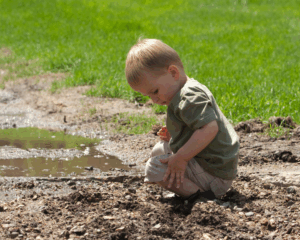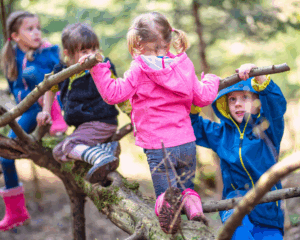Tessa Robinson, published 24 th July 2025
It is special to see kids discovering the outside world, the wind on their faces, the puddle-jumping, and the viewing of bugs under some logs. Outdoor learning is not a trend to early years professionals but is something we value greatly as the way to support children in developing, connecting and growing.
Outdoor learning has ever been a learning experience that has been close to my heart. Growing up in an army family, we didn’t always have the same neighbourhood or the same friends, but we always had the great outdoors. Trees became climbing frames, fallen branches turned into den-building kits, and every day was an exploration mission. There was something my parents would say to each other and their friends: Kids are not allowed to be kids until they were good at falling out of trees. It was that simple feeling that defined our perception of the world; then it was practical, conceptual and kind of rough up.
Learning in the open can be a woodland ramble, garden hideaway or an afternoon on the beach, but whatever it is, you can guarantee one thing learning out in the greater open air is something special to a child.
To a large extent, such an upbringing deeply roots in the outdoor play forms my current perception of development and risk. Not as things to avoid but as things that provide experiences to learn by. That is why I am so convinced in the need to make sure that not just outdoor learning is welcomed but it is properly supported both practically and through adequate risk/safety management. Working so closely with providers throughout the UK, I have experienced the transformative nature of the same process as children are given the freedom to create, explore and push self boundaries in ways that are so rarely given to them as adults.
To say that the pro is in the benefits but the logistics are not so simple. And like any other practice, to safely and confidently deliver outdoor learning we need thought, planning and the right support, including the support of our insurance provider.
The Importance of the Outdoor Learning:
Learning outside gives birth to resilience, curiosity, independence and joy. It promotes early literacy and numeracy through life-purposive ways and encourages children to attain strong bodies and experience risk taking and social development.
The value of outdoor learning is increasingly becoming recognised in early years frameworks across the UK and providers are being prompted to incorporate it as a central and significant contribution to children learning and growth.
However, when one goes out of the classroom, there is a varied consideration.From changing weather conditions to public spaces and varied terrain, there’s more to think about in terms of safety, accountability, and responsibility.
Understanding Risk – Not Avoiding It:
Risk is not the enemy of outdoor learning, unmanaged risk is. It can be a powerful tool for learning when it’s understood and appropriately managed.
Of course, letting children explore comes with responsibility. But risk doesn’t have to mean danger. It can mean freedom when managed well. It’s about equipping children to assess, adapt, and thrive, just as we did when balancing on logs or navigating nettles in makeshift jungle missions. That same principle underpins the way we think about insurance and support at Morton Michel – not as a constraint, but as an enabler of rich, authentic learning.
Many providers already carry out thorough dynamic risk assessments and put strong safety measures in place. But it’s also important to understand how your insurance interacts with this. Particularly when you’re heading beyond your premises.
For example, most specialist childcare insurance policies (Morton Michel’s included) will outline activity conditions (the key criteria that must be met for certain activities to be insured) or point to requirements such as obligations to take reasonable precautions to protect property and persons under your duty of care.
Activity conditions might include things like:
- Ensuring written risk assessments are in place for activities off-site or involving natural hazards
- Keeping to appropriate staff-to-child ratios
- Having parental permissions recorded
- Seeing that activities are monitored and that any adventurous activities (such as climbing trees or playing with rocks in water) are designed and suitable to the age of the children
- Avoiding practices that are explicitly prohibited (unattended access to deep water, or use of equipment that is outside a childs developmental stage)
There are these conditions under which you have to act, but those aren& to hamper you, they are there to see that you have safe confident practice and that in the event that something does go wrong no-one gets hurt.
What Insurance Brings to the Table:
Good insurance should never be a barrier to outdoor learningIt ought to be a background quiet assurance. The correct policy will facilitate your effectiveness in providing rich, varied experiences as well as understanding the challenges of doing so in constantly changing conditions, working with children.
Instead of considering insurance as something additional to your pedagogy, consider it as a component of your broader safeguarding strategy and visualise it as an addition to training, procedures, and reflection.
In a nutshell, insurance does not become a barrier to travelling, provided you use it intelligently.
It enhances it.
Tips for Safer Outdoor Learning
- Update your risk evaluation on a regular basis and tailor them to each location and each activity and not only to the place to go but how you will get there and what you will do upon arrival.
- Make it a practice to go through your insurance paperwork on an annual basis. In particular, the activity conditions or exclusions section. Speak up- question when unsure.
- Where feasible, ensure your team are trained to identify and manage risks dynamically that can involve but not limited to change in weather, wildlife etc.
- Ensure up-to-date allowances of evidence, accident and near-miss. They can unveil tendencies and aid planning in future.
- Allow yourself to conduct debrief after each outing. Which was good and better and what was learning observed?Working Together to Support Confident Practice:
Our objective at Morton Michel is to ensure that we assist in the best practice, we are not there to dictate what providers may or may not do. We realise that there is no one size fits all nor limit to outdoor learning and we are proud to work with settings whose approaches are as varied as the environments they visit.
This is why we continually update our policies to reflect the changing needs of the sector, such as making what is covered (and not covered) clear and when it extends to off-site activities, where they constitute part of your normal provision in early years.
We also urge providers to be active communicators with their insurers and not only when there is a problem. A brief discussion of a planned effort or a new method can provide solid assurance and prevent surprises in the future.
Let Nature Lead
UK is abundant in natural spaces and early years settings all over the country are taking advantage of it. Through park spaces in the city centres to woods and beaches, the opportunities are enormous to learn by doing, moving, constructing and creating through play.
And the same thing, let us continue to enable those experiences, but not to eliminate risk, to handle it in a thoughtful way and have the confidence and support of the profession behind us.
Why not, all children thrive when they are given freedom to discover.And when providers are supported to deliver outdoor learning safely, the whole community benefits.
Bio – Gary Harrison, Head of Operations at Morton Michel:
With over 17 years at Morton Michel and more than two decades in the insurance industry, Gary is passionate about supporting the childcare and education sectors through meaningful, risk-aware partnerships. An inclusive practice and sector innovator. Gary and his colleagues in Morton Michel liaise with providers, insurance specialists and insurers to make sure that insurance represents the practical realities of early years professionals.






